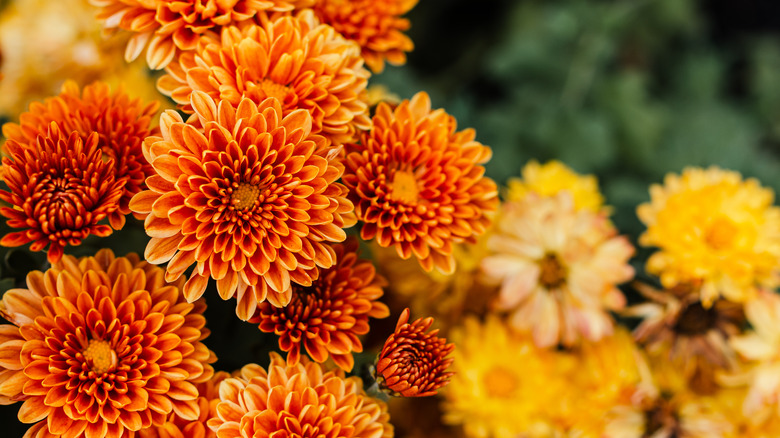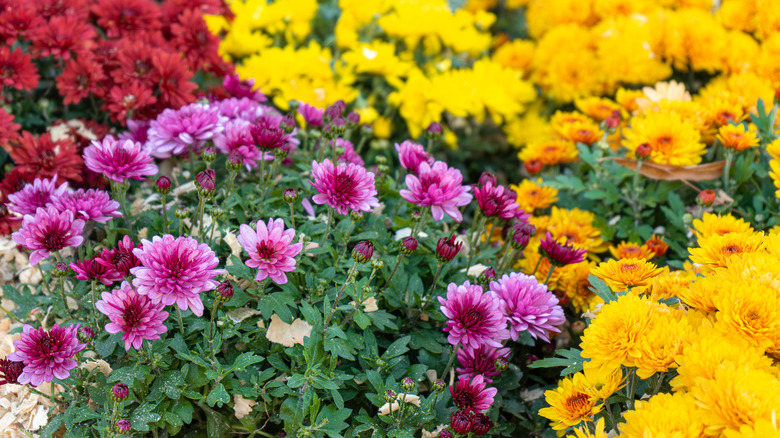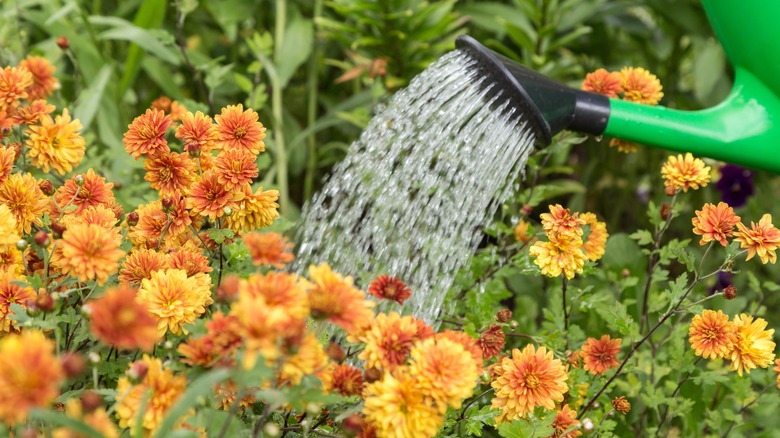Why You Should Plant Mums In The Spring, According To Our Professional Gardener
Many people buy potted mums as annuals in late summer and autumn without realizing that they make wonderful perennials that increase in size each year. These potted mums can be planted, but they don't always survive. One tip for getting mums to come back to your garden every year is to plant bare root mums, from mail order sources or divisions from other gardeners. Planting mums in the spring allows them to become well established and perennial in your garden.
Planting late season potted mums is definitely an option, but the larger the plant, the less likely it is that it will successfully transition to becoming perennial. This is because these larger "basket" mums are pruned to produce many flower buds, and this draws a lot of energy from the plant. After all those flowers bloom, the plant is left depleted, and planting it just before winter often means it has a lower chance of survival. Also, larger potted mums are often root bound, which can weaken the plant. Small potted mums (in 4- or 6-inch pots) have a slightly better chance at making it than large ones when planted in the fall, in my experience.
Planting a mum in the springtime means it has time to become acclimated to your garden and to grow strong roots. Although many mums are cold hardy, some varieties are less so, and planting potted mums in autumn can be risky. An early hard frost can make it difficult for the plant to survive that first winter.
Choosing bare root mums
Choosing which bare root mums to plant is one of the most enjoyable spring garden tasks for me. There's a delicious sense of anticipation thinking about late summer turning to autumn when the mums explode into color. One of my favorite suppliers for bare root mums is Bluestone Perennials, which has a wonderful selection including unusual mum types like button mums and football mums. Gilbert H. Wild also sells bare root mums (and many other perennials) for great prices.
Mums have different flowering times: some start blooming in late summer, while others begin flowering in mid or late autumn. Knowing this timing can help you decide where to plant them in your garden based on when they bloom and where you might need some color. Mums also have different growing zones depending on the variety, so make sure you choose mums that are cold hardy for your location.
One advantage to getting bare root mums in spring is that the selection from mail order vendors is usually much wider than what is available in garden shops and nurseries. I rarely see button mums or football mums in nurseries, but mail order catalogs often have plenty of them available. There's also a much wider range of colors beyond the usual white, orange, yellow, pink, and purple for sale at most plant stores or nurseries. You can make the most of your late season garden palette with mums in unusual colors like peach, coral, lavender, burgundy, and bronze.
Planting bare root mums
Bare root mums are usually sold via mail order in the spring, and they start shipping in April. When your bare root mums arrive, they will usually be potted and wrapped up. They may already be blooming flower stems if the vendor forces blooms, but these will wither quickly or you can prune them off. Once planted, a mum will go through its normal growing cycle once it's established.
Mums love plentiful sunlight and well-drained soil rich in organic matter. Plant your bare root mum with some compost to give it a good start, and water it immediately. You should water your newly planted mum every day for 10 days to help it get established. Make sure to water regularly as the season progresses — this is the secret to long-lasting blooms on your mums. Your spring-planted bare root mum should be right on schedule for its bloom time and increase in size every year.
Once they're established as perennials, mums wake up rather slowly in spring. You should start to see young leaves poking up in April. Once the stems get at least 3 inches high and the leaves start forming pairs, you can start pinching them back. Just use your fingernails, or garden snips if you prefer, to pinch off the top pair of leaves in the stem. This will encourage more budding and branching for fuller plants with more flowers. Divide your perennial mums every two or three years in springtime.


